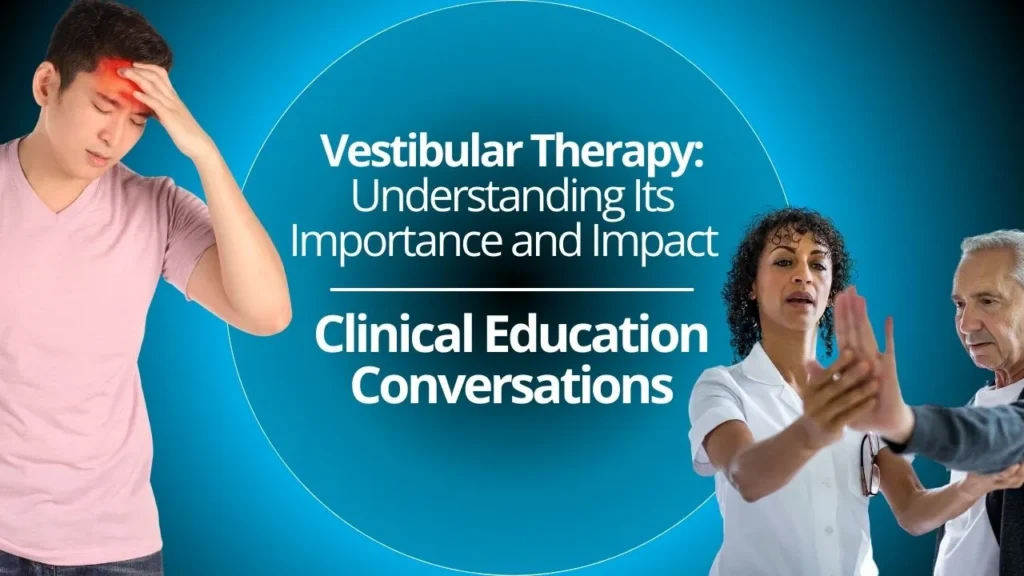
Vestibular therapy is an essential field within physical therapy that addresses various dysfunctions related to the vestibular system—the part of the inner ear and brain that helps control balance and eye movements.
Misunderstandings about vestibular symptoms and treatment are common, but awareness and education can significantly improve patient care.
What is Vestibular Therapy?
Vestibular therapy, often misunderstood as merely dealing with ‘dizziness,’ covers a wide range of symptoms and conditions stemming from the vestibular system.
The vestibular system is crucial for maintaining balance and orientation.
In a recent Clinical Conversations discussion, Physical Therapists, Ashley Langford, Mark Martire, and Caitlin Whiteley, discuss the basics and nuances of vestibular dysfunctions such as BPPV (benign paroxysmal positional vertigo), where crystals in the inner ear become dislodged, causing severe dizziness and balance issues.
Understanding Vestibular Dysfunction
Vestibular dysfunction can be debilitating, affecting every aspect of an individual’s life. The symptoms often lead to a reduced quality of life due to fear of movement and potential injury from falls.
For clinicians it is important to understand the various aspects of these issues, and that they are not limited to older adults—anyone can be affected, from children to athletes to the elderly.
The causes of vestibular dysfunction vary widely, from genetic predispositions to environmental factors and lifestyle choices.
Diagnosis and Challenges
Diagnosing vestibular dysfunction involves a combination of patient history, physical examinations, and possibly diagnostic imaging.
The education on vestibular issues in medical and physical therapy schools is often limited. New graduates are often under-prepared to effectively diagnose and treat these conditions.
The complexity of the vestibular system’s symptoms and their subjective nature makes diagnosis and subsequent treatment challenging but crucial.
Treatment Techniques
Effective treatment of vestibular dysfunctions involves a multifaceted approach, including manual therapies, repositioning maneuvers, and tailored exercises.
A targeted Vestibular Rehabilitation Therapy (VRT) plan will address the specific needs of the patient, which can lead to rapid improvements.
Treating vestibular dysfunction can be very rewarding for the clinician, as patients often see quick progress, restoring their balance and quality of life in just a few sessions.
The Role of Physical Therapists in Vestibular Therapy
Physical therapists (PTs) play a crucial role in managing vestibular dysfunction.
PTs employ various techniques to help retrain the brain to cope with the changes in the vestibular system. Manual aspects of treatment can include repositioning crystals in the inner ear, and exercise components that help patients manage and mitigate symptoms.
Within the continuing education community, there is a consensus on the need for more specialized training in vestibular and concussion therapy within the healthcare profession.
Impact on Patients
Patients with vestibular issues often experience a profound impact on their daily lives.
The symptoms can be frightening and isolating, leading to anxiety and depression.
Proper treatment will help most patients regain a significant portion of their normal function and independence.
Vestibular therapy has a transformative effect, providing emotional and physical relief that patients feel when their symptoms are effectively managed.
Vestibular Education and Awareness
There is a pressing need for better vestibular and concussion continuing education and awareness.
Increasing awareness can lead to earlier diagnosis and treatment, significantly improving outcomes.
Additionally, advocating for more comprehensive training in physical therapy programs and continuing education will equip more clinicians able to help more patients.
Conclusion
Vestibular therapy is a vital but often overlooked area of physical therapy.
It requires a detailed understanding of the vestibular system and a compassionate approach to patient care.
Providing vestibular care offers significant opportunities for professional growth and patient relief.
For those suffering from vestibular dysfunction, understanding and accessing effective vestibular therapy can mean the difference between a life of discomfort and one of recovery and hope.